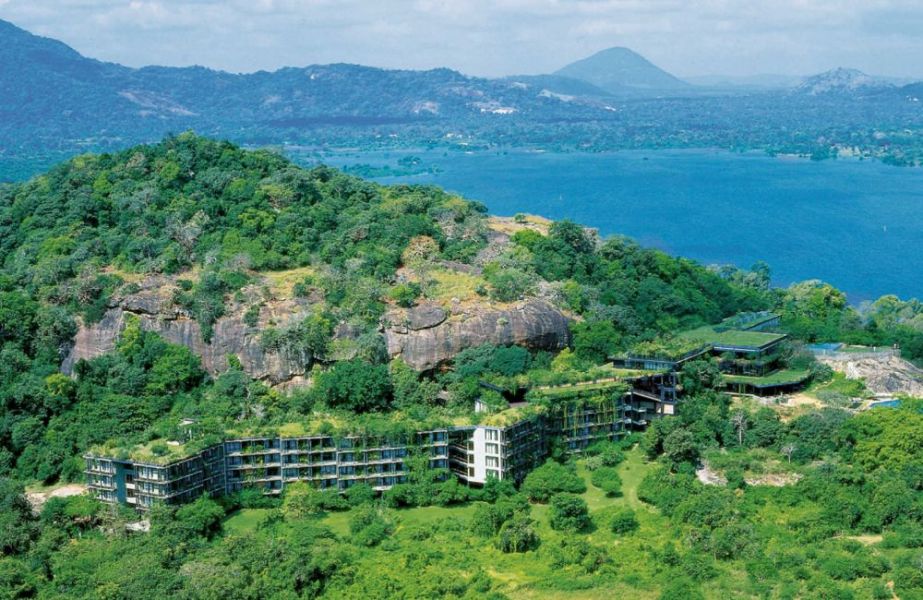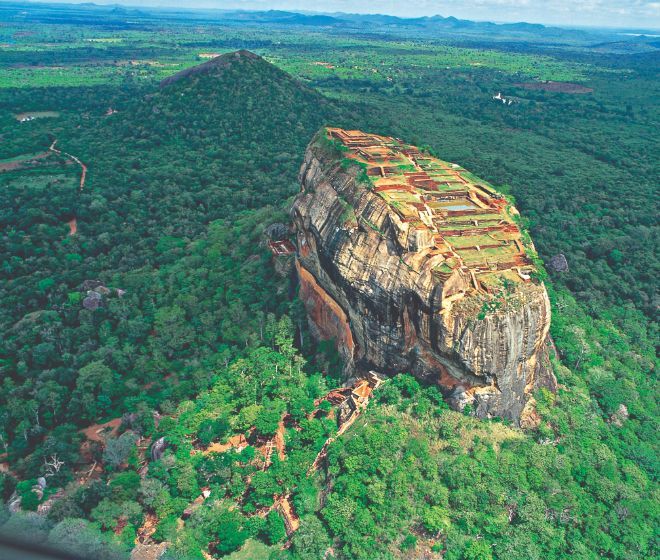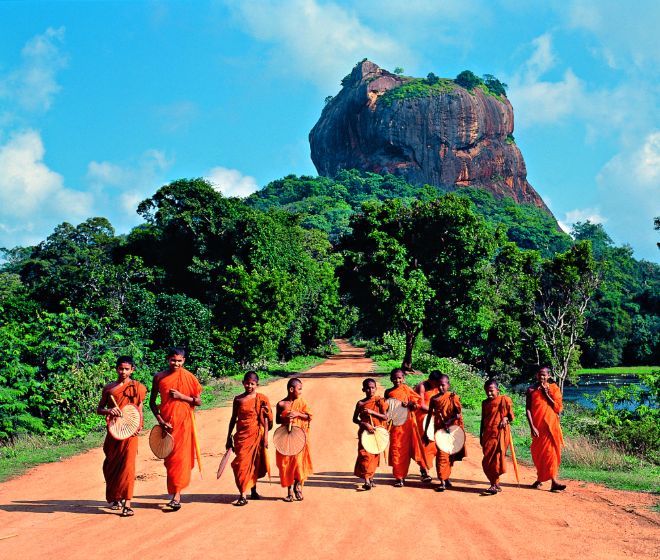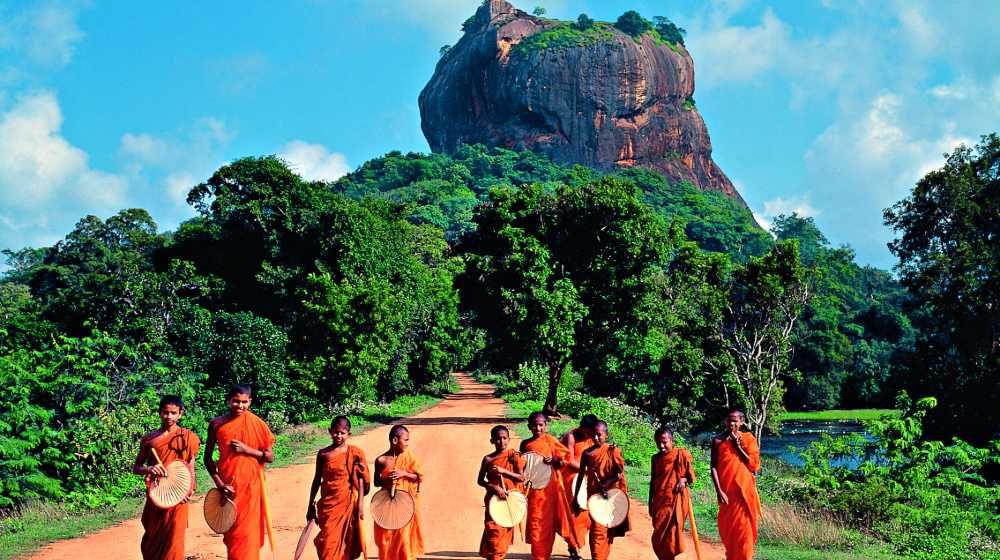
Sigiriya Rock Fortress Sri Lanka
What is Sigiriya ?
Sigiriya is an ancient rock fortress and palace built by King Kashyapa during the reign of 473 – 495 which is standing majestically 660 feet straight up. It is located in the northern Matale district near the town of Dambulla in central province of Sri Lanka. The word Sigiriya or the Sinhagiri means the Lion’s Rock where you have to climb up 1200 steps before you reach the Lion Rock Fortress on top of Sigiriya. There are several platforms that break up the steps and allow for a little break if you need it. Today Sigiriya rock fortress is one of the most famous Archeological Treasure and UNESCO named Sigiriya rock as a World Heritage in 1982 under the name “Ancient City of Sigiriya Sri Lanka”.
Architecture of Sigiriya Lion Rock
This fortified garden city of Sigiriya rock fortress is an exceptional master piece of ancient urban planning / landscape & architecture / construction technology /exceptional hydraulic engineering & management / ancient fine art with unique harmony between nature and human imagination and all these living examples proved that it was a Well Planned City & Palace in 5th Century AD. Sigiriya rock fortress is recognized as one of the best preserved surviving ancient urban sites in Asia from the 1st millennium or simply it’s a Living Museum. Sigiriya World Heritage Site is versatile and many-faceted appeal, and it is one of Sri Lanka’s ancient political capitals and Sri Lanka’s most sensational heritage site.
History of Sigiriya Rock Fortress
Historical research carried out at the site has brought to light evidence to show that the origins of Sigiriya date back to pre-historic times. Situated at the base of the Sigiriya rock of its eastern side, is a monadnock named Aligala (Elephant Rock). In a cave underneath this, excavation have revealed remains of pre-historic human settlements that existed here around 5,500 years B.P. In addition, there is evidence of human habitation in this area, as far back in history as the 9th — 10th centuries B.C.
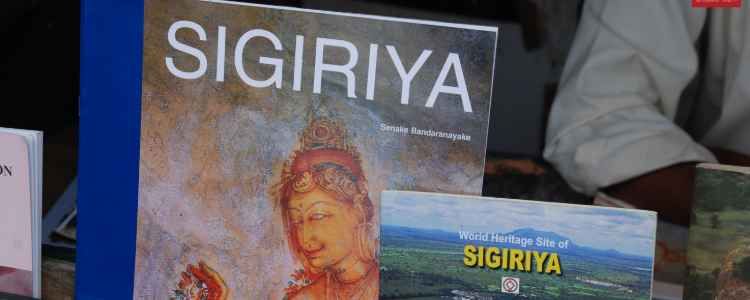
In the 3rd century B.C. a Buddhist monastery had been established at Sigiriya rock fortress. Thirty cave-shelters with drip-ledges, which accommodate monks, have been identified at the base of the great rock so far. In eight of them, details of donations of cave shelters have been inscribed in Brahmi script.
All the principal structures that are found today in Sigiriya, have been erected during the reign of King Kasyapa (A.D. 477 - 495), who chose to make Sigiriya as his seat of administration. According to the eminent archaeologist Prof: Senerath Paranavithana, Sigiriya reflects the sensuousness of a pleasure-loving king, who modeled the city on the mythical Alakamanda of god Kuvera. Indian and Roman coins and pottery belonging to the Sassanian dynasty of Persia (Iran) found in Sigiriya rock fortress as well as the affinity to Persian styles in the creation of pleasure gardens all indicate commercial and cultural relations with foreign countries during this brief period.
Sigiriya Lion Rock Fortress in 7th AD
Subsequently however, in the 6th and 7th centuries A.D., Sigiriya ceased to be of political importance and once again became the abode of Buddhist monks. During this period, the cave-shelters with drip-ledges which belonged to the earlier monastic phase were further improved. Additional shrines such as stupa, image house and bodhi tree shrine were constructed. This second phase of the monastic development continued up to the 12th - 13th centuries A.D.
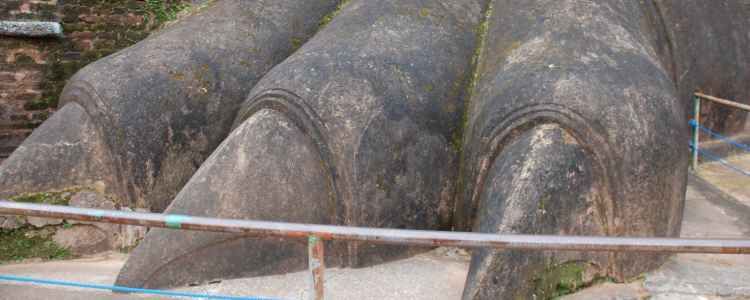
19th Century Sigiriya Rock
In the centuries that followed, Sigiriya was totally abandoned, until the 19th century, when it was used as n military out-post of the kings of Kandy. Later, it was a British military. officer, Jonathan Forbes in 1832, who once again brought Sigiriya out of its obscurity, back into historical focus. In 1894, under H.C.P. Bell the Archaeological Department commenced archaeological activities in Sigiriya. Nearly a century later, in 1982, the Central Cultural Fund took over the task, which it continues with great success, to date.
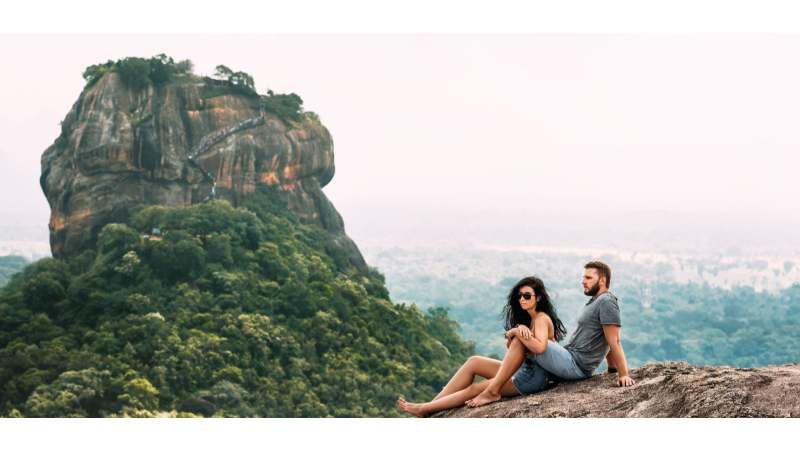
City Planning of Sigiriya Rock
The Lion rock Sigiriya has two fortified precincts where the western precinct encompasses 90 hectares, and the eastern precinct covers 40 hectares. The western area was the royal park area, a symmetrically-designed pleasure garden with elaborate water-retaining structures, as well as surface and subsurface hydraulic systems. It is surrounded by three ramparts and two moats, forming a rectangular area whose inner precincts measure about 700 meters from east to west and 500 meters from north to south.
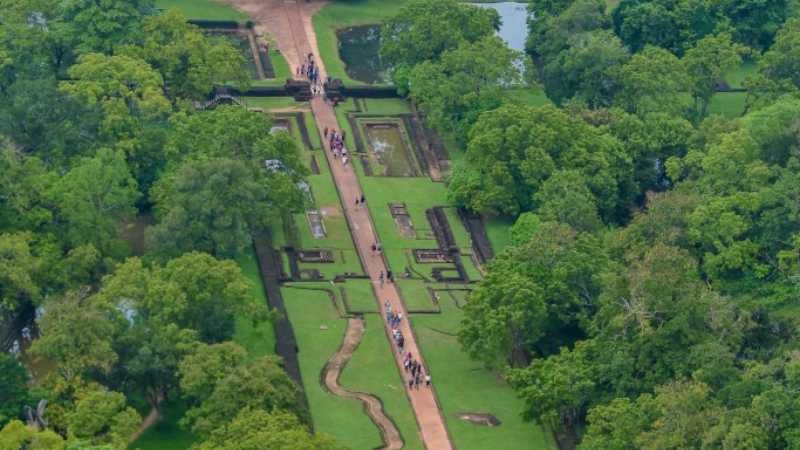
On the other side of the Lion rock Sigiriya, the eastern area appears to have been a ceremonial precinct with a large central pavilion as its only permanent structure. Kasyapa and his royal family lived their lives within these walls. Moving inward from the two precincts in an ever-ascending fashion are a series of boulder gardens and then terraced gardens, leading to the entrance to the Sigiriya rock. Access to the rock is gained via a long passageway that begins on the west side of the terrace gardens, and winds northward along the Mirror Wall to the Lion Platform.
Water Garden / Landscape & Gardening of sigiriya
Among the significant features of Sigiriya, the Water Gardens are especially noteworthy. Though outwardly the Water gardens appear to be one garden system in Concept, four distinct parts are clearly discernible in its creation, and at present they are called the Water Garden Nos. 1, 2 and 3 and the Miniature Water Garden.
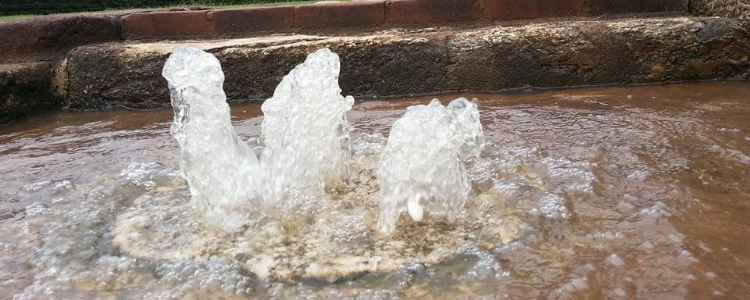
The Water Garden No. l has symmetrically arranged four larges ’L’- shaped ponds creating an island in the middle. This is considered a special feature found in ancient garden designs and is termed “Char-Bagh’ and this specimen in Water Garden No. 1 seems to be the most ancient one extent in the world today. The Water Garden No. 2 has fountains, and hence is also called the Fountain Garden. Two summer palaces flank either side of this Fountain Garden. Visitors will wonder how the fountains were fed with water. The answer lies in the moats built round the summer palaces, connected tó concealed subterranean channels, which feed . the. fountains ingeniously arid unobtrusively. Water Garden No. 3 is located at a higher elevation and has and asymmetrical lay-out, the balance and symmetry of the other sections of the garden system being absent here. . The Miniature Water Garden is a ‘miniaturized’ refinement of the other three garden systems, a kind of micro scale-model of die total concept. The inter-connection between the different parts of the Water Gardens and the Overall balance,' symmetry and integration. Thereby achieved is indeed a triumph.
Lion Rock Sigiriya Graffiti
Main features of Sigiriya rock are Sigiri graffiti, Lion’s paw entrance, Boulders garden, Mirror wall, Fresco paintings of female figures, Extensive networks of landscaped garden, Water gardens, Moats, Ramparts and the remains of the palace.
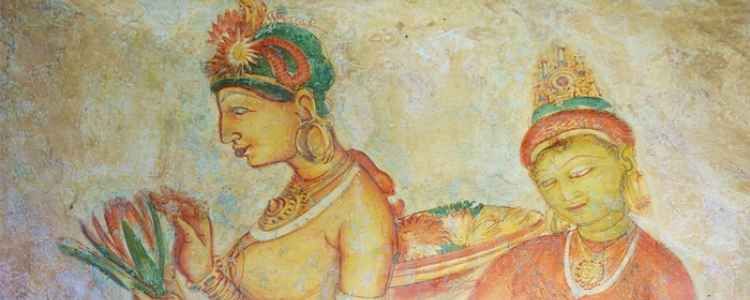
The lion rock Sigiriya Graffiti were written on the surface of the Mirror Wall at Sigiriya. Scribbled on the wall are over 1800 pieces of prose, poetry and commentary written by ancient tourists. These graffiti offer a fascinating insight into the history of Sigiriya and the evolution of language in Sri Lanka over a period of 800 years. The majority of the graffiti refer to the beautiful paintings of semi-nude females. These graffiti confirm that this site was the residence of King Kashyapa who ruled from 477 to 495 AD. The texts also suggest that the females depicted in the frescoes are the ladies of the King's royal court - the ladies of the harem.
The graffiti range from statements of awe, declarations of love, commentary, curses, laments, diary entries, or mere statements of visit.
Many demonstrate a very high level of literacy and a deep appreciation of art and poetry written in a Sinhala, Sanskrit and Tamil. These early scribblers have left us priceless insights into the past. Out of these paintings 685 individuals identified so far, 12 were women, over half identified themselves by name, many noted their social rank, and some even mentioned where they came from towns like Weligama and Ritigala in Sri Lanka. The majority of these visitors appear to have been from the elite of society: royalty, officials, professions, and clergy. There were also soldiers, archers, and even metalworkers. Over 1000 unique words have been identified.
Boulder Garden of Lion Rock Sigiriya
The Boulder Garden comprises sloping terrain around the central rock which is dotted with boulders of various sizes. The routes to the palace on the rock summit are laid out through the boulder garden as winding pathways that are punctuated by natural boulder arches. Among the unique features of this garden are the Cistern Rock deriving its name from a large cistern formed out of the natural boulder and large granite slabs, the ‘Audience Hall’ where a five-meter long main throne is carved out of the living rock, the ’Preaching Rock’ where a seat is carved out at the flattened edge of a fairly high boulder, and the ‘ Asana Cave’ where a seat is carved out inside a natural cave. Rock caves with drip-ledges and shrines used during the periods when Sigiriya was a Buddhist monastery are also to be seen in this area. The Terraced Garden of Sigiriya Lion Rock lies in the high ground between the Boulder Garden and the Sigiriya rock and it is fashioned into a series of roughly concentric terraces by means of stone retaining walls.
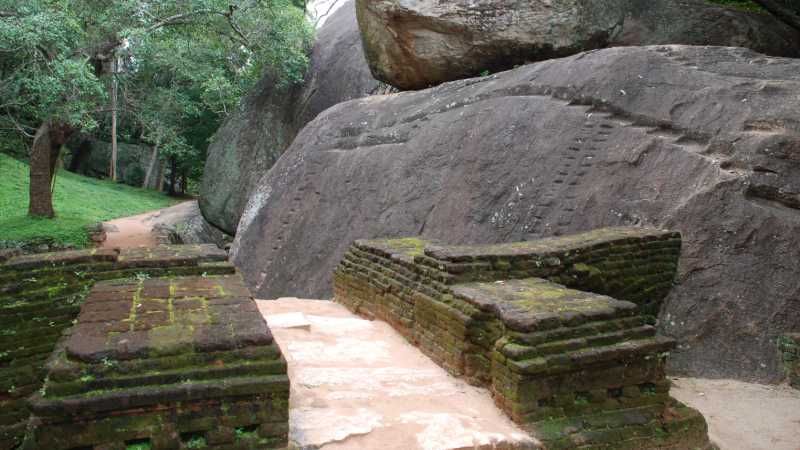
Lion Staircase
The final ascent to the royal palace atop Sigiriya rock lies through the Lion Staircase, which faces north and has two huge paws of a lion in front. These lion-paws, made of brick and covered with plaster, are the remnants of a fore part of lion figure that must have once stood there.
Palace Complex of Sigiriya Lion Rock
The Palace Complex on the top of the Sigiriya rock is around 1.5 hectares in extent. The principal monument to be seen there is the royal palace which lies towards the west. The palace garden consisting’ of a large artificial pool and. other garden features are located to the east. Below the palace, on a rock facing the east is a throne carved out of the natural rock.
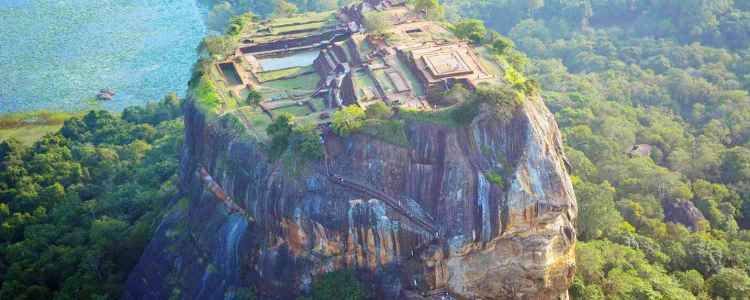
Lion Rock Paintings
The fifth century A.D. paintings are indisputably the zenith of all artistic creations of Sri Lanka. These paintings, found in a depression on the western side of the rock-face, nineteen in number, are figures of exquisitely beautiful damsels, floating among clouds. According to the Sigiri graffiti (verses scratched on the Mirror Wall over the ages) however, there had been five hundred such figures painted all over the western and northern rock-faces, originally.
Many theories attempt to interpret the. identity of the beautiful women portrayed in these ancient masterpieces. According to H.C.P Bell, they are Kasyapa’s concubines, on their way to worship at the Pidurangala temple near by, bearing flowers for offering. According to the eminent scholar Ananda Cnomaraswamy, the damsels are Apsaras or goddesses. The eminent Sri Lankan archaeologist . Prof. Senerat Paranvitana offers a very original interpretation of the identity of the Sigiriya damsels, which maintains that the damsels are symbolic representations of rain-clouds and lightning. According to this interpretation, the dark- skinned maidens (Meghalatha) are symbols of rain clouds and fair golden skin once Vajji Kumari symbolized lightning. Apart from these paintings, Caves in the Boulder Garden also appear to have contained paintings. The Deraniyagala Cave, Cobra-hood Cave and Asana Cave show clear traces of paintings. In addition to this, it has been recently discovered that there had been paintings on the outer surface of the Mirror Wall. Though these paintings are all faded, one female figure, apparently floating among clouds, can be discerned.
The Terracotta figurines, closely resembling tire figures in the. paintings have been discovered at Sigiriya during archeological excavation. According to Prof. Senaka Bandaranayake, who headed the major archeological projects in Sigiriya, these may be replicas of Sigiriya Damsals sold to visitors as souvenirs in the past.
How Sigiriya related to Ramayana Yatra Sri Lanka ?
Cobra Hood Cave & Ramayana Yatra Sri Lanka
Cobra hood cave also known as the “Parumaka Naguliya Lena”, is a natural geological formation projected as a cobra hood located within the boulder garden of Sigiriya Rock Fortress complex with plastered interior of the cave once embellished with floral and animal paintings. This is also part of the Sigiriya Rock Fortress complex (UNESCO World Heritage)
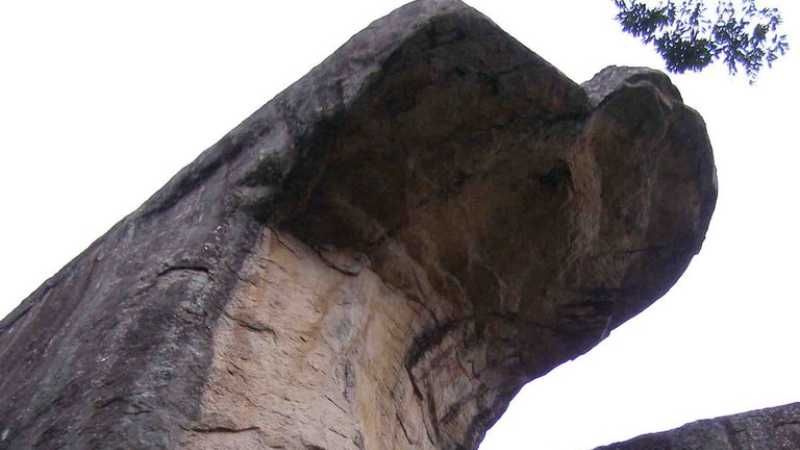 As per the recent explorations of Ramayana in Lanka Pura by Mr. Lal Srinivas and Dr. Mirando Obesekara, Sigiriya can be considered as a post historical archaeology turning point of King Ravana. According to them, Sigiriya may be the Alakamandava or City of the Gods that was built up before 50 centuries ago by King Kuvera who was the half brother of King Ravana as defined in the Ramayanaya yatra Sri Lanka.
As per the recent explorations of Ramayana in Lanka Pura by Mr. Lal Srinivas and Dr. Mirando Obesekara, Sigiriya can be considered as a post historical archaeology turning point of King Ravana. According to them, Sigiriya may be the Alakamandava or City of the Gods that was built up before 50 centuries ago by King Kuvera who was the half brother of King Ravana as defined in the Ramayanaya yatra Sri Lanka.
According to the Palm Leaf Book (Puskola Potha) of Ravana Watha (Ravana Story) the architect of the Sigiriya was a Danava called Maya Danava. He built up Sigiriya on the instructions given by King Visthavasa (Vishravasamuni) the father of Ravana. During that period the Sigiriya was called Alakamandava and during the period of King Kuwera it was called Cithranakuta. After the death of Ravana, Vibeeshana became the king and he shifted the kingdom to Kelaniya.
The man-made drip ledge and Brahmi inscription of the 3rd century B.C. associated with this cave indicate that the cave has served as a Buddhist monastery / dwelling for monks. The paintings on the rock ceiling has floral and stylized animal motifs with a geometric composition. The brick paved floor of the cave has been finished with lime plaster. The boulder connected with the cave has been sliced from the mother boulder and resembles the hood of a cobra. A fallen off piece of the boulder is still to be seen in front of the cave.
Therefore hhistorians believe Sigiriya to have a connection with Ramayana. It is believed that the plateau top was the site of Ravana’s majestic palace, made of solid gold and crafted by Kubera, the God of Wealth, around 50 centuries ago. One look at the site, and you would know how big an architectural feat this place must have been. As believed, one of these caves is where King Ravana imprisoned Princess Sita, after abducting her.
Skeletal discovered at Cobra Hood Cave Sigiriya
The archaeological excavations conducted at the cave / rock shelter has led to the discovery of nine human skeletons. Excavations at the Sigiriya Cobra Hood Cave excavated what appears to be a Middle Historic Period burial site. The excavations yielded skeletal remains of nine individuals. This study suggests that at the time of death these individuals were young healthy adult males of 152 cm or more in height. Burial practice has been in an extended position in a west-east orientation with hands clasped in front and the face turned towards the south. No burial offerings or other ritual objects were found.
Sigiriya Rock Fortress FAQ
What is Sigiriya Famous for?
Sigiriya is a best-preserved ancient rock fortress and one of the archeological treasure in South Asia. It’s a masterpiece of ancient urban planning / landscape & architecture / construction technology /exceptional hydraulic engineering & management / ancient fine art with unique harmony between nature and human imagination. Thus UNESCO declared this site as a World Heritage
Who Built the Sigiriya rock?
A Sri Lankan King Kashyapa built the famous Sigiriya lion rock
How many steps are in Lion Rock Sigiriya to climb?
Approximately 1,200 steps are to be climbed to the summit.
What is the height of the lion rock sigiriya?
Its 660 Feet from surrounding plain
Is it hard or danger to climb lion rock Sigiriya ?
Its is not danger to climb but make sure you are healthy enough to climb 1,200.
Can senior citizen climb Sigiriya lion rock fortress?
Yes people do and you may take time and climb. There are places for you to take rest and climb.
We suggest you to keep senior citizen in nearby restaurant and climb. Also you may let them to visit the Sigiriya museum close to the main gate.
Can I climb lion rock with my infant or kid ?
Not recommended but people do climb with kids like 8 Y and above.
Opening time of Sigiriya lion rock for visitors ?
7.00 AM to 5.00 PM
Entrance fees for lion rock Sigiriya
30 USD per person / Foreign
15 USD per person only for SAARC Countries nationals (Need to submit the passport to get this discount)
What is the best time to climb Sigiriya lion rock?
Ideally in the morning 8 – 10 Am or 3 – 5 PM to avoid hot sun
What is the temperature of Sigiriya lion rock ?
Approximately 27 – 30 C
Can I buy Sigiriya lion rock entrance fees ticket online ?
Not yet as of now but this will be online soon
What is the dress code for Sigiriya Lion rock?
Sigiriya is not a temple or any religious place and you can wear your own dress.
Reference
-
CCF – Central Cultural Fund Sri Lanka
-
SLTDA – Sri Lanka Tourism Development Authority
-
SLITHM – Sri Lanka Institute of Tourism & Hotel Management

